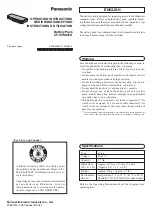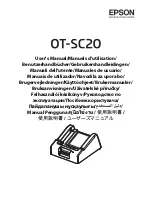
Solar Battery Charger/Maintainer
OWNERS MANUAL
READ THE ENTIRE MANUAL BEFORE USING THIS PRODUCT. FAILURE TO DO SO COULD RESULT IN SERIOUS INJURY.
1. IMPORTANT SAFETY INSTRUCTIONS – SAVE THESE INSTRUCTIONS
1.1 SAVE THESE INSTRUCTIONS – This manual contains important safety and operating instructions.
WARNING: RISK OF ELECTRIC SHOCK OR FIRE.
1.2 Keep out of reach of children.
1.3 Use only recommended attachments. Use of an attachment not recommended or sold by the battery charger manufacturer may result in a risk of fire, electric shock or
injury to persons or damage to property.
1.4 To reduce the risk of electric shock, disconnect the clamps from the solar charger before attempting any maintenance or cleaning.
1.5 Do not operate the solar charger if it has received a sharp blow, been dropped or otherwise damaged in any way; take it to a qualified service person.
1.6 Do not disassemble the solar charger; take it to a qualified service person when service or repair is required. Incorrect reassembly may result in a risk of fire or electric shock.
WARNING: RISK OF EXPLOSIVE GASES.
1.7 WORKING IN THE VICINITY OF A LEAD-ACID BATTERY IS DANGEROUS. BATTERIES GENERATE EXPLOSIVE GASES DURING NORMAL BATTERY OPERATION.
FOR THIS REASON, IT IS OF UTMOST IMPORTANCE THAT YOU FOLLOW THE INSTRUCTIONS EACH TIME YOU USE THE SOLAR CHARGER.
1.8 To reduce the risk of a battery explosion, follow these instructions and those published by the battery manufacturer and the manufacturer of any equipment you intend to
use in the vicinity of the battery. Review the cautionary markings on these products and on the engine.
1.9 Locate this solar charger 18 inches (45.72 cm) or more above floor level. Do not place on wet ground, anywhere it could be accidently stepped on or in a place or position
where it could fall while being used.
2. PERSONAL PRECAUTIONS
WARNING: RISK OF EXPLOSIVE GASES.
2.1 NEVER smoke or allow a spark or flame in the vicinity of a battery or engine.
2.2 Remove personal metal items such as rings, bracelets, necklaces and watches when working with a lead-acid battery. A lead-acid battery can produce a short-circuit
current high enough to weld a ring or the like to metal, causing a severe burn.
2.3 Be extra cautious to reduce the risk of dropping a metal tool onto the battery. It might spark or short-circuit the battery or other electrical part that may cause an explosion.
2.4 Use this solar charger for charging LEAD-ACID batteries only. It is not intended to supply power to a low voltage electrical system other than in a starter-motor application.
Do not use this solar panel for maintaining or charging dry-cell batteries that are commonly used with home appliances. These batteries may burst and cause injury to
persons and damage to property.
2.5 NEVER charge a frozen battery.
2.6 Consider having someone close enough by to come to your aid when you work near a lead-acid battery.
2.7 Have plenty of fresh water and soap nearby in case battery acid contacts your skin, clothing or eyes.
2.8 Wear complete eye and body protection, including safety goggles and protective clothing. Avoid touching your eyes while working near the battery.
2.9 If battery acid contacts your skin or clothing, immediately wash the area with soap and water. If acid enters your eye, immediately flood the eye with cold running water for
at least 10 minutes and get medical attention right away.
2.10 If battery acid is accidentally swallowed, drink milk, the whites of eggs or water. DO NOT induce vomiting. Seek medical attention immediately.
3. PREPARING TO CHARGE
WARNING: RISK OF CONTACT WITH BATTERY ACID. BATTERY ACID IS A HIGHLY CORROSIVE SULFURIC ACID.
3.1 If it is necessary to remove the battery from the vehicle to charge it, always remove the grounded terminal first. Make sure all of the accessories in the vehicle are off to
prevent arcing.
3.2 Be sure the area around the battery is well ventilated while the battery is being charged.
3.3 Clean the battery terminals before charging the battery. During cleaning, keep airborne corrosion from coming into contact with your eyes, nose and mouth. Use baking
soda and water to neutralize the battery acid and help eliminate airborne corrosion. Do not touch your eyes, nose or mouth.
3.4 If appicable, add distilled water to each cell until the battery acid reaches the level specified by the battery manufacturer. Do not overfill. For a battery without removable
cell caps, such as valve regulated lead acid batteries (VRLA), carefully follow the manufacturer’s recharging instructions.
3.5 Read, understand and follow all instructions for the solar charger, battery, vehicle and any equipment used near the battery and solar charger. Study all of the battery
manufacturer’s specific precautions while in use.
3.6 Determine the voltage of the battery by referring to the vehicle owner’s manual and make sure that the output voltage of the solar charger is the correct voltage.
3.7 Make sure that the solar charger cable clamps make tight connections.
0099002367-01
MODEL
SA1589





















